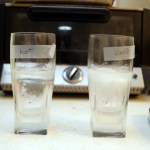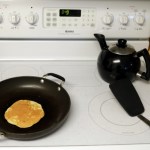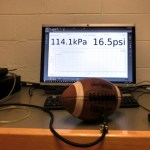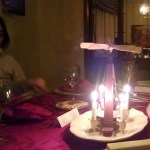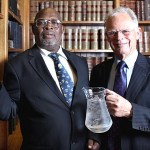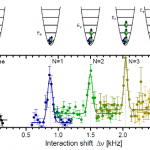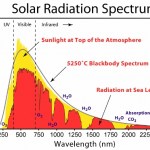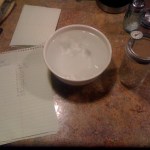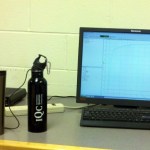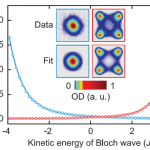Thermo/StatMech
One of my favorite modern tales of scientific discovery is the Mpemba Effect, named after Erasto Mpemba, a schoolboy in Tanzania who noticed while making ice cream that hot mix put in the freezer solidified faster than cold. This counter-intuitive result has been replicated a bunch of times, and physicists and chemists continue to debate the reason for it.
It was bitterly cold this weekend, dipping down into the negative Fahrenheit, which wasn't great for, you know, leaving the house, but did provide an opportunity to test the Mpemba Effect. Because when the icy winds of winter blow, that's a…
The image here of a pancake cooking isn't particularly interesting in its own right, other than as documentation of our weekend ritual at Chateau Steelypips. Saturday and sunday mornings, Kate sleeps in while the kids watch cartoons and I cook pancakes for them. SteelyKid absolutely drowns hers in maple syrup, then refuses to eat them, while The Pip regularly wolfs down two plain pancakes, eating with his hands:
A pancake cooking at Chateau Steelypips.
As I said, this image isn't especially interesting, but it's here mostly as a teaser for a different thing, namely this thermal-imaging…
We're having a brutal cold snap at the moment, and while today's early-morning dog walk was considerably warmer than yesterday's, it was still 0F/-18C out, which is way colder than I like. When I came back in the house after the walk, my glasses instantly fogged up. But I had to take some stuff outside for the recycling, and within a few seconds of stepping back outside, they cleared right back up.
Now, I knew that would happen (which is why I hadn't bothered to wipe them off inside), but in one of those physicists-are-a-little-weird moments, for the first time, it occurred to me to wonder…
I know I said I was done with this story, but this was actually recorded last week: The Daily Planet show on Discovery Channel in Canada contacted me last week when all this deflated-football silliness was exploding, and got a cameraman to come over and record me talking about it. The episode aired Monday night, January 26th, and you can stream it from their archives at the link above (I think it should be episode 216, but when I looked just now, it was just "Episode 16," but the date is correct. My bit is toward the end, starting around the 35:00 mark, but you should totally watch the whole…
The low-level cold I've been nursing for a month now finally exploded into the full unpleasantness of my usual winter illness Saturday, or else I would've been more active following up on my Deflategate article and my ideal gas law post. As it was, for most of the day, I could barely keep on top of clearing comments from moderation.
Anyway, a few things deserve more prominent responses than a comment at the end of a long post, so:
-- I was in bed during the great Bill Belichick press conference, though I saw some mockery of it come across Twitter. While it may not have played well with the…
So, as mentioned yesterday, I got an email asking me about the weird scandal involving the Patriots and underinflated footballs, so I wrote a piece for the Conversation on the subject. since a few people had beaten me to citations of the Ideal Gas Law, though, I decided to bring my own particular set of skills into this, and did an experiment.
[UPDATE: I've added some follow-up/concluding remarks in a separate post from Sunday 1/25. So, if you care about my reaction to Belichick's big press conference, go over there.]
You can see the basic set-up at the link-- I got a couple of footballs from…
One of the cool things about working at Union is that the Communications office gets media requests looking for people to comment on current events, which sometimes get forwarded to me. Yesterday was one of those days, with a request for a scientist to comment on the bizarre sports scandal surrounding the deflated footballs used in the AFC Championship game this past weekend. Which led to me doing an experiment, and writing a short article for The Conversation:
News reports say that 11 of the 12 game balls used by the New England Patriots in their AFC championship game against the…
One of my favorite Christmas presents this year was a Seek Thermal camera to use with my Android phone. This allows for a lot of idle physics-y fun, taking pictures of things in thermal mode.
One idea I had was to do a sort of follow-up to the test of my insulated mug that I did a couple of years ago with a PASCO thermocouple probe. That showed a really dramatic difference between my metal IQC water bottle and the insulated mug, in terms of the rate at which hot water placed in each cooled. So, how do these look in thermal imaging?
Well, I took my insulated mug (actually a different one than…
One of my Christmas gifts this year was a Seek Thermal camera, so I can continue my transformation into Rhett Allain. What's this for? Why, physics, of course. Such as this video of the operation of the Christmas pyramid my parents picked up in Germany, and had set up at the start of Christmas dinner:
Sadly, the Seek Thermal app doesn't seem to record audio with the video, so you miss out on SteelyKid's running commentary about the whole thing... But you can fairly clearly see the plumes of hot air rising up from the candle to push the vanes of the fan. There's probably a way to estimate the…
Another weekend day, another story I'm going to outsource a bit. In this case, to the original scientist, who at the time of his discovery was a 13-year-old schoolboy in Tanzania:
In 1963, when I was in form 3 in Magamba Secondary School, Tanzania, I used to make ice-cream. The boys at the school do this by boiling milk, mixing it with sugar and putting it into the freezing chamber in the refrigerator, after it has first cooled nearly to room temperature. A lot of boys make it and there is a rush to get space in the refrigerator.
One day after buying milk from the local women, I started…
Two papers with a similar theme crossed my social media feeds in the last couple of days. You might think this is just a weird coincidence, but I'm choosing to take it as a sign to write about them for the blog.
So, what are these papers, and what's the theme? One is the final publication of some results I saw at DAMOP and alluded to back in June, and the other is from this post by Doug Natelson. Both look at the transition from few-body to many-body physics.
And this is interesting, why? I mean, isn't it obvious that you just add some more bodies? OK, I guess that does need a little more…
Via social media, John Novak cashes in a Nobel Betting Pool win from a while back, asking:
Please explain to me the relationship between energy, entropy, and free energy. Like you would explain it to a two year old child.
Why? There is a statistical algorithm called Expectation Maximization which is often explained in terms of those three quantities. But apparently entropy is hard to understand because all the detail in the analogy is heaped on entropy part (with some side tracks in Kullback-Leibler divergences.) Since I have a background in communication theory, entropy is a perfectly…
Through some kind of weird synchronicity, the title question came up twice yesterday, once in a comment to my TED@NYC talk post, and the second time on Twitter, in a conversation with a person whose account is protected, thus rendering it un-link-able. Trust me.
The question is one of those things that you don't necessarily think about right off-- of course an atom is a particle!-- but once it gets brought up, you realize it's a little subtle. Because, after all, while electrons and photons are fundamental particles, with no internal structure, atoms are made of smaller things. But somehow we…
I'm putting together slides for a TED audition talk in a couple of weeks, about how the history of quantum mechanics is like a crossword puzzle. This involves talking about black-body radiation, which is the problem that kicked off QM-- to explain the spectrum of light emitted by hot objects, Max Planck had to resort to a mathematical trick: he assumed that the objects were composed of "oscillators" that emitted light in discrete amounts, with the energy of the emitted light proportional to the frequency of the light. This was a desperation move, and made him a little crazy:
Max Planck…
Writing up the evaporative cooling post on cold atom techniques, I used the standard analogy that people in the field use for describing the process: cooling an atomic vapor to BEC is like the cooling of a cup of coffee, where the hottest component particles manage to escape the system of interest, and what's left behind is colder. The departing atoms or coffee molecules carry off more than the average energy per particle, leaving a lower average energy (and thus a lower temperature) for the remainder.
A question that sometimes comes up when I talk about this is how you can possibly use this…
In our last installment of the cold-atom toolbox series, we talked about why you need magnetic traps to get to really ultra-cold samples-- because the light scattering involved in laser cooling limits you to a temperature that's too high for making Bose-Einstein condensation (BEC). This time out, we'll talk about how you actually get to those ultra-cold temperatures.
What do you mean? I assumed it was just part of the trapping process? No, because the forces involved in magnetic trapping are like those involved in optical dipole traps. In physics jargon, they're "conservative" forces, which…
Hey, dude? Yeah, what's up?
I'm not normally the one who initiates this, but I was wondering: When you were at DAMOP last week, did you see any really neat physics? Oh, sure, tons of stuff. It was a little thinner than some past meetings-- a lot of the Usual Suspects didn't make the trip-- but there were some really good reports from a lot of groups.
Anything really surprising? Well, there was one talk that I really liked a lot, that I went to on a lark, because I didn't understand what the session title could possibly mean, and there was no abstract for the talk: Experimental Studies of…
It's been a while since I've done a post over-analyzing some everyday situation, because I've been too busy to do any silly experiments. We're on break this week, though, so I took a little time Monday to bring excessive technology to bear on the critically important scientific question: how good is my insulated Starbucks cup?
To back up a little bit, because it's always important to provide background and motivation when writing a lab report, I spend a lot of time working at Starbucks these days, because when I try to get work done in my office, people keep showing up wanting me to do stuff…
This past weekend, I was at Boskone, where I appeared on a few science-y panels. One of these was on the possibility of beaming power down from space:
Energy From Space
Beam me down some juice, Scotty? Let's talk about the possibilities -- and practicalities -- of really long-distance power transmission.
Tom Easton (M), Jordin T. Kare, Chad Orzel, Jeff Hecht, Joan Slonczewski
This was a little odd, as Jordin does this for a living-- he's been working on a proposal to NASA for a solar power generating satellite that would use lasers to beam power down to photovoltaic panels on the ground--…
Last week's post talked about the general idea of negative temperature, with reference to this much-talked-about Science paper (which also comes in a free arxiv version from which the figures used here are taken). I didn't go into the details of how they made a negative temperature gas, though, and as it's both very clever and hard to follow, I figure that deserves a post of its own.
Right, so last time you said that negative temperature just means you're more likely to find fast-moving atoms than slow ones, so all they need to do is whack these atoms in the right way? Right? No, it's more…
